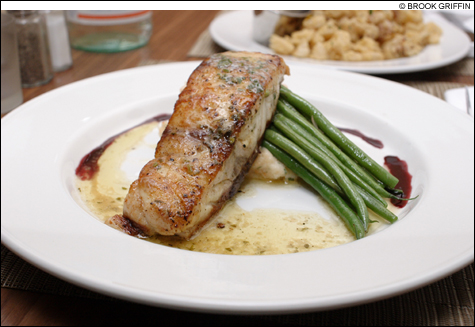
PAN-ROASTED SEA BASS: Actually striped bass, with green peppers and lobster mashed
potatoes — it’s first class. |
Cafeteria | 279A Newbury Street, Boston | Open daily, 11:30 am–10 pm | AE, MC, VI | Beer and wine | No valet parking | Entrance down 8 steps from sidewalk level | 617.536.2233 |
The early buzz on Cafeteria was that some staff from the lamented Armani Café were going to try and transplant that high-fashion vibe to their new endeavor. Two problems: Armani Café was a light and airy upstairs dining room, while Cafeteria is mostly below street level. Armani Café had, at least when I reviewed it soon after it opened, incredible food. Cafeteria doesn’t. It has credible food, and what now have to be considered moderate prices (other than the wines), served in a cute, too-loud room with very high seating.Food begins well with crusty Italian bread and top-quality extra-virgin olive oil. My favorite appetizer was fried calamari ($9), which came to the table piping hot and still crisp, with a fine spicy mayonnaise. Minestrone ($7) tasted fresh and vegan. I would have liked some grated cheese to mellow it.
But an eggplant napoleon ($9) showed a heavy hand at the deep fryer. The discs of eggplant were overly breaded and browned, layered into a stack with spinach, cheese, and tomato. It made for good eating, not great. (You would do a lot better with the eggplant rollatini at Ricardo’s in the North End.) Another appetizer, roasted-beet salad ($9), is getting too familiar. Like crème brûlée, it needs a twist. Cafeteria’s is a simple one: three colors of beets, string beans, goat cheese, walnuts, and a balsamic dressing. I get more concentrated flavor when I roast beets at home, so maybe these weren’t actually roasted.
The best entrée I tried was pan-roasted sea bass ($29). We had the server check what kind of bass it was, since we don’t eat Chilean sea bass (unsustainable fishery, too much mercury), and the local black sea bass seldom get past the Chinese-restaurant chefs. “It’s a wild sea bass from here,” said the server. Well, it turned out to be a fine chunk of striped bass, which will not show up locally for about five months, but it did taste wild and fresh. With green beans and lobster mashed potatoes, this was first class. Gnocchi with short ribs ($20) is a nice winter stew, featuring beefy chunks in salty gravy, with dumplings (the literal translation of gnocchi) that weren’t feather light but certainly decent enough.
Veal Milanese ($22), however, was another leaden fry job. The veal flavor was overwhelmed, and the plate was only saved by a nifty arugula salad and a few grape tomatoes. Tagliatelle Bolognese ($18) was proper, chewy ribbons of pasta, served with a burger-ish sauce where one might have expected a lighter Italian meat sauce with veal.
The wine list has tasty offerings, though the prices seem to start around triple their retail values, with little under $30 per bottle. When I started this job, restaurants charged double retail, and wine was a lot cheaper to begin with. I agree that wine is better now, but I’m not sure these markups are going back to the winemakers. Cafeteria compounds the error by serving reds in glasses that would be a little small even for white wines. That all said, our 2005 Delas Frères Côtes du Rhône ($32) was an outstanding example of its kind. The Delas brothers get a lot of dark cherry-berry fruit into their blend, and it lingers a little on the palate.
Desserts are mostly familiar, and again good without distinction. The exception was the apple crisp ($8), which wasn’t crisp but sweet and spicy, with terrific gingersnap ice cream stealing the platter. The sorbets ($8) were mango (actually tastes like mango), raspberry (always the strongest sorbet flavor), and lemon (so-so). You can choose all three, or one or two.
Warm chocolate cake ($9) didn’t taste sufficiently of chocolate. Lemon panna cotta ($8) didn’t taste sufficiently of lemon, but that was because it was too creamy. Some will not regard this as a fault, but I like a lighter panna cotta that is more obviously a gelatin dessert. Those can be unmolded and will hold their shape; this one was served in an ice-cream dish.
The room appears cozier than it is, because the seats are covered in cork-look vinyl, and the floor with cork-colored vinyl tiles. Real cork absorbs sound. Smooth cork-look surfaces, however, reflect sound, as do plate-glass windows, a faux-marble bar, mirrors, and the fronts of TV sets. Background techno music might help with ambience; on a quiet early-weeknight visit, it was hard to tell. One great improvement to this room (in a space where a lot of restaurants, including Café L’ananas and Saffron, have come and gone) is a functional set of draft curtains at the front door.
Service was excellent and quick. Our waiter was unfazed by a complex order, sea-bass questions, and the tricky design of the room. There’s nothing obviously wrong with the location, but it has killed a long succession of apparently attractive restaurants. Cafeteria is pitched a little differently than this room’s former inhabitants, appealing to shoppers at lunch and those seeking a bar-restaurant at dinner. That may be a better strategy, and a better way to approach the menu.
Robert Nadeau can be reached at RobtNadeau@aol.com.